Number Code to Color
Have you ever wondered how numbers can be transformed into colors? The fascinating concept of number code to color allows us to convert numeric values into visually appealing representations. This concept finds applications in various fields, including art, computer graphics, and data visualization. In this article, we will explore how number code to color works and delve into its practical uses.
Key Takeaways
- Number code to color involves converting numeric values into visually represented colors.
- This concept is utilized in various fields such as art, computer graphics, and data visualization.
- The hexadecimal code is commonly used to represent colors in HTML and CSS.
Number code to color is based on the relationship between numbers and colors. By assigning a specific color to a given number, we can create a unique visual representation. The most commonly used method to represent colors in HTML and CSS is through hexadecimal code. This is a six-digit code that combines numbers and letters from A to F to define a particular color. For example, the hexadecimal code for pure red is #FF0000, and for pure green it is #00FF00.
One interesting way number code to color is utilized is in data visualization. By assigning different colors to different data points, we can create visual representations that are easily interpretable. For instance, in a bar chart where each bar represents a data point, we can assign colors to the bars based on their values. This not only makes the chart more visually appealing but also enhances data comprehension.
Using Number Code to Color in HTML and CSS
In HTML and CSS, we can utilize number code to color by specifying the hexadecimal code within the appropriate tags or attributes. For example, to make a heading text appear in red, we can use the following code snippet:
<h1 style="color: #FF0000">This is a red heading.</h1>
With this code, the text within the <h1> tags will appear in red color. This technique can be applied to various elements, such as text, backgrounds, borders, and more, allowing for endless possibilities in web design and customization.
Tables: Color and Hexadecimal Code Examples
| Color Name | Hexadecimal Code |
|---|---|
| Red | #FF0000 |
| Green | #00FF00 |
| Blue | #0000FF |
Here are some examples of commonly used colors and their corresponding hexadecimal codes:
- Red: #FF0000
- Green: #00FF00
- Blue: #0000FF
Practical Uses of Number Code to Color
The application of number code to color extends beyond web design and data visualization. Here are a few practical uses:
- Art: Artists can incorporate number code to color in their artwork, exploring the relationship between numbers and visual expression.
- Accessibility: Number code to color can be used to improve accessibility by providing alternative representations, such as converting numeric data into color patterns for visually impaired individuals.
- Psychology: The study of color psychology involves understanding the associations between colors and emotions. Number code to color can play a role in this field by assigning emotional states to specific numbers, which can then be represented by corresponding colors.
Conclusion
Number code to color is a fascinating concept that allows us to transform numeric values into visually represented colors. This concept finds applications in various fields, from web design and data visualization to art and psychology. By understanding and utilizing number code to color, we can enhance visual expression and communication in our work and daily lives.

Common Misconceptions
Misconception 1: Number codes to color are universal
One common misconception about number codes to color is that they are universally understood and can be interpreted the same way by everyone. This is not true as different industries, cultures, or even individuals may use different number codes to represent colors.
- Number codes for colors vary across different programming languages
- Graphic designers might use different number code systems depending on their preferences
- Cultural differences can impact the interpretation and usage of number codes for colors
Misconception 2: All number codes correspond to a specific color
Another misconception is that all number codes represent a specific color and can be easily translated. In reality, number codes for colors often need to be converted or mapped to a particular color space or system in order to accurately display the desired color.
- Some number codes may require additional information or settings to display correctly
- Different devices or software might interpret number codes differently, leading to variations in displayed colors
- Color transformations may be required to convert number codes between different color spaces
Misconception 3: Number codes for colors are always intuitive
One misconception is that number codes for colors are inherently intuitive and easy to understand. While some color systems may follow a logical pattern or structure, others can be complex and require knowledge of specific color models or conventions.
- Hexadecimal color codes may be less intuitive for those unfamiliar with the hexadecimal numbering system
- Some color systems require understanding of color theory concepts to accurately interpret the codes
- Different color models (RGB, CMYK, HSL, etc.) have their own unique logic and interpretations
Misconception 4: Number codes determine the exact perception of color
Many people mistakenly believe that number codes for colors determine the exact perception of color by individuals. However, human perception of color can be influenced by various factors, such as lighting conditions, personal preferences, and even colorblindness.
- Individuals may perceive colors differently due to differences in color receptors or visual impairments
- Color appearance can be influenced by surrounding colors or the context in which it is presented
- Subjective factors like personal experiences and cultural associations can affect color interpretation
Misconception 5: Number codes for colors are limited to digital applications
Some people believe that number codes for colors are only used in digital applications. However, color number codes have been used in various fields long before the digital age, such as printing, textile industry, and even traditional arts.
- In pre-digital times, color books often used number codes to specify ink mixtures
- The textile industry utilizes number codes to specify dye recipes for producing consistent colors
- Traditional artists may use number codes to reference specific pigments in their artwork

Colors and Their Meanings
Colors have the power to evoke various emotions, symbolize different concepts, and even affect our mood. The following table explores some common colors and their associated meanings.
| Color | Meaning |
|---|---|
| Red | Symbolizes love, passion, and energy |
| Blue | Associated with serenity, trust, and intelligence |
| Yellow | Represents happiness, optimism, and creativity |
| Green | Symbolizes nature, growth, and renewal |
| Purple | Associated with royalty, luxury, and spirituality |
| Orange | Represents enthusiasm, warmth, and vitality |
| Black | Symbolizes power, elegance, and mystery |
| White | Associated with purity, innocence, and simplicity |
| Pink | Represents femininity, sweetness, and compassion |
| Gray | Symbolizes neutrality, balance, and sophistication |
Favorite Foods Around the World
Fascinatingly, culinary preferences vary across different countries. Here are some popular dishes enjoyed worldwide.
| Country | Favorite Dish |
|---|---|
| Italy | Pizza Margherita |
| Japan | Sushi |
| India | Butter Chicken |
| Mexico | Tacos al Pastor |
| Thailand | Pad Thai |
| France | Croissant |
| Greece | Moussaka |
| China | Kung Pao Chicken |
| United States | Hamburger |
| Brazil | Feijoada |
World Population by Continent
The following table displays the population figures for each continent as of the year 2021.
| Continent | Population |
|---|---|
| Asia | 4,641,054,775 |
| Africa | 1,345,727,573 |
| Europe | 747,636,026 |
| North America | 597,524,051 |
| South America | 429,191,023 |
| Oceania | 45,239,448 |
Top 10 Highest Grossing Movies
Hollywood often captivates audiences worldwide with its blockbuster films. Here are the top 10 highest grossing movies of all time.
| Movie | Box Office Revenue (in billions) |
|---|---|
| Avengers: Endgame | 2.798 |
| Avatar | 2.790 |
| Titanic | 2.194 |
| Star Wars: The Force Awakens | 2.068 |
| Avengers: Infinity War | 2.048 |
| Jurassic World | 1.671 |
| The Lion King (2019) | 1.657 |
| The Avengers | 1.518 |
| Furious 7 | 1.516 |
| Avengers: Age of Ultron | 1.402 |
Annual Rainfall in Different Cities
Rainfall patterns vary greatly across different cities worldwide. Here are some cities and their average annual rainfall figures.
| City | Rainfall (in mm) |
|---|---|
| Tokyo, Japan | 1,528 |
| Mumbai, India | 2,257 |
| London, United Kingdom | 602 |
| Mexico City, Mexico | 820 |
| Cairo, Egypt | 25 |
| Sydney, Australia | 1,193 |
Mobile Operating System Market Share
With the rise of smartphones, various mobile operating systems have competed for market dominance. Here’s a look at the current market share.
| Operating System | Market Share |
|---|---|
| Android | 72.8% |
| iOS | 26.7% |
| Other | 0.5% |
World’s Tallest Buildings
Architectural marvels, skyscrapers, have become iconic structures. The table below showcases the world’s tallest buildings.
| Building | Height (in meters) |
|---|---|
| Burj Khalifa, Dubai | 828 |
| Shanghai Tower, China | 632 |
| Abraj Al-Bait Clock Tower, Saudi Arabia | 601 |
| Ping An Finance Center, China | 599 |
| Lotus Tower, Sri Lanka | 350 |
Major World Religions
Religion serves as a source of spiritual guidance and cultural significance for many people. Here are some major world religions.
| Religion | Approximate Number of Followers |
|---|---|
| Christianity | 2.6 billion |
| Islam | 1.9 billion |
| Hinduism | 1.2 billion |
| Buddhism | 520 million |
| Judaism | 14 million |
Gross Domestic Product (GDP) Rankings
The GDP of a country reflects its economic strength. The table below showcases the top 5 economies in the world based on GDP.
| Country | GDP (in trillions of USD) |
|---|---|
| United States | 22.68 |
| China | 16.64 |
| Japan | 5.38 |
| Germany | 4.00 |
| United Kingdom | 2.83 |
Colors, favorite foods, population, movies, rainfall, mobile operating systems, tall buildings, religions, and GDP rankings showcase the diverse aspects that shape our world. These tables not only provide valuable data but also offer interesting insights into various topics globally.
Frequently Asked Questions
How does number code convert to color?
The number code to color conversion is based on mapping numbers to specific color codes. Each number is associated with a particular color value, and when the code is executed, it translates the numbers into their corresponding colors.
What is the purpose of number code to color?
Number code to color allows for a creative way of representing data or information visually. It can be used in various applications such as data visualization, image processing, or even art projects.
How can I use number code to color in my projects?
You can use number code to color in your projects by incorporating the code into your programming language or software. Simply assign the desired number values to specific colors and implement the conversion logic accordingly.
Are there any specific number-to-color mappings?
Number-to-color mappings can vary depending on the coding conventions or specific requirements of your project. You have the flexibility to define your own mappings or use existing conventions, such as the RGB color model or hexadecimal color codes.
Can number code to color be used for accessibility purposes?
While number code to color can be visually appealing, it’s important to consider accessibility. Relying solely on color may exclude individuals with visual impairments. It’s recommended to provide alternative ways of conveying information, such as using text labels or patterns.
Are there any limitations to number code to color?
Number code to color has some limitations. It primarily represents discrete values in a continuous color space, limiting the range of possible colors. Additionally, it may not be suitable for representing complex or multivariate data where color alone might not be sufficient.
Can I convert color back to number code?
Yes, it is possible to convert color back to number code. The reverse process involves extracting the color information from an image or representation and mapping it back to the corresponding number values based on your predefined mappings.
What are some popular applications of number code to color?
Number code to color has various applications. It is commonly used in data visualization, computer graphics, image processing, and even generative art. It offers a visually engaging way of representing information or adding aesthetic value to projects.
Can I customize the number-to-color mappings?
Absolutely! You have full control over the number-to-color mappings in your projects. You can define your own mappings based on personal preferences or adapt them to match specific coding conventions or color schemes.
Where can I find resources to learn more about number code to color?
There are numerous resources available online to delve deeper into the concept of number code to color. Websites, blogs, tutorials, and online communities focused on programming, computer graphics, or data visualization can provide valuable insights and examples.





